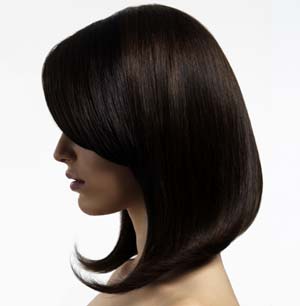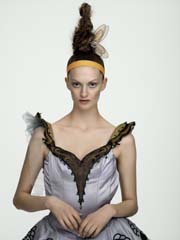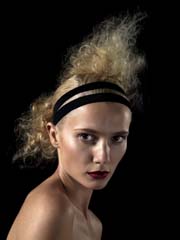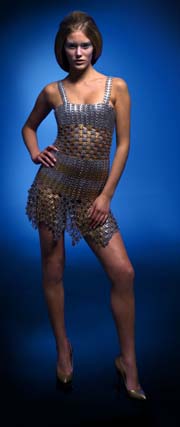|
beauty:
hair
 Schwarzkopf’s new season: four the new way Schwarzkopf’s new season: four the new way
Schwarzkopf
gets four trends from the catwalk, including one that takes us back
to the future
creative direction by Steve Hogan/Schwarzkopf
trend report directions by Tyler Johnston/Premier
make-up by Alexsandra Byrne
Expanded from issue 24 of Lucire

The siren style
THE HAIR BUSINESS has always kept
an eye on catwalk trends. It makes sense: as far as consumers are
concerned, a lot of beauty coverage comes in fashion magazines like
Lucire, rather than bespoke titles that are aimed more at
the trade.
Schwarzkopf, for this season, identified its
Essential Looks from fashion as being futurism, two-tone, siren
and the dancer.
Futurism ties in well with the trends Lucire
has projected for the summer, identifying the shimmery, silver tones
that were prevalent on catwalks earlier in the year. Trend-wise,
too, futurism is an acknowledgement that there has been too much
emphasis on retro design over the last 10 years, exemplified by
products such as the Volkswagen New Beetle and clothing that has
been very clearly 1970s- and 1980s-inspired.
After all—and older readers can associate with
this—the 21st century was meant to be a time of spacesuits, food
in pill form, and electric cars.
Schwarzkopf sees this trend as ‘sleek’ and ‘razor
sharp’, citing collections from Balenciaga, Hussein Chalayan, Gareth
Pugh and Versace. The company believes trends will include angular
lines, with a “non-violent” violet orange complementing
the colours on one side of the parting. Alternatively, the style
can be represented in dark violet and light ruby.
Its two-tone approach is about combining ‘Pared-down
luxury and off-beat modernism—simple, streamlined silhouettes with
tone-on-tone.’ Modernism seems to be on the ball, too—when Lucire
first went into print, it seemed to be the movement that would take
hold by mid-decade.
The new modernism—as opposed to postmodernism—emphasizes
the contrast between black and white, championing the monochrome
and minimalism. Jean-Pierre Braganza, Marc Jacobs, Gareth Pugh,
Yves St Laurent, Chanel and Versace are cited as influences.
Schwarzkopf forecasts medium-length hair with
broken lines and sloping fringe, and platinum blonde as the shade
representing this style. It also suggests an ‘A-line shape with
long layers and soft sloping fringe’ as a second style, with colours
of rich browns and deep golden syrup, the effect being a high-shine
finish.
Siren is perhaps more obvious—less a design movement,
more a feminine type in itself. ‘Power dressing for super-lux starlets,’
states the company, building on the colours seen at Alberta Ferretti
(magenta), Balenciaga (bright blue), Jenny Packham (gold), Prada
(violet), Valentino (red) and Versace (mauve). Cut-wise, the look
features rounded layers with a heavy fringe, separating the head
into three bold sections. Colours suggested include dark blackberry,
bright cherry and pale strawberry ice or pale velvet rose, suggesting
pluralism.
A second style cut features looser layers with
a mid-length fringe, adopting auburn–gold tones.
The dancer, to us, is more an eastern look, though
it is not mentioned by Schwarzkopf itself. The look’s vintage detailing
and retro styling acknowledges that we have not totally rid ourselves
of the rear-view mirror, always inevitable in fashion.
Dolce & Gabbana, Michael Kors, Valentino,
Viktor & Rolf, Y-3 by Yamamoto and Hussein Chalayan all showed
shorter hair on the catwalks.
Schwarzkopf, meanwhile, indicates that the cut
is a ‘free-flowing layered shape with texture and movement,’ based
around triangles. Light blonde is the main trend colour; though
nutmeg, almond and rich browns are forecast for colours that express
the overall style.
The looks were previewed in Auckland during the
winter, and are hitting Schwarzkopf salons now. •
Add
to Del.icio.us | Digg
it | Add
to Facebook
|

The dancer dressing

Two-tone dressing

Futurism dressing
After all—and older readers can associate—the 21st
century was meant to be a time of spacesuits, food in pill form,
and electric cars
|

